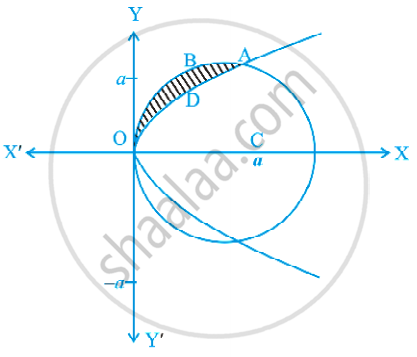Advertisements
Advertisements
प्रश्न
Find the area of the region bounded by the curve y2 = 2x and x2 + y2 = 4x.
उत्तर
Equations of the curves are given by x2 + y2 = 4x ......(i)
And y2 = 2x ......(ii)
⇒ x2 – 4x + y2 = 0
⇒ x2 – 4x + 4 – 4 + y2 = 0
⇒ (x – 2)2 + y2 = 4
Clearly it is the equation of a circle having its centre (2, 0) and radius 2.

Solving x2 + y2 = 4x and y2 = 2x
x2 + 2x = 4x
⇒ x2 + 2x – 4x = 0
⇒ x2 – 2x = 0
⇒ x(x – 2) = 0
∴ x = 0, 2
Area of the required region
= `2[int_0^2 sqrt(4 - (x - 2)^2) "d"x - int_0^2 sqrt(2x) "d"x]`
∴ Parabola and circle both are symmetrical about x-axis.
= `2[(x - 2)/2 sqrt(4 - (x - 2)^2) + 4/2 sin^-1 (x - 2)/2]_0^2 - 2*sqrt(2)* 2/3 [x^(3/2)]_0^2`
= `2[(0 + 0) - (0 + 2 sin^-1 (-1)] - (4sqrt(2))/3 [2^(3/2) - 0]`
= `-2 xx 2 * (- pi/2) - (4sqrt(2))/3 * 2sqrt(2)`
= `2pi - 16/3`
= `2(pi - 8/3)` sq.units
Hence, the required area = `2(pi - 8/3)` sq.units
APPEARS IN
संबंधित प्रश्न
Find the area of the region bounded by the curve y = sinx, the lines x=-π/2 , x=π/2 and X-axis
Find the area of ellipse `x^2/1 + y^2/4 = 1`
Find the area of the region bounded by the parabola y2 = 4ax and the line x = a.
Sketch the graph y = | x + 3 |. Evaluate \[\int\limits_{- 6}^0 \left| x + 3 \right| dx\]. What does this integral represent on the graph?
Find the area of the region bounded by x2 + 16y = 0 and its latusrectum.
Draw a rough sketch and find the area of the region bounded by the two parabolas y2 = 4x and x2 = 4y by using methods of integration.
Find the area of the region bounded by \[y = \sqrt{x}\] and y = x.
Sketch the region bounded by the curves y = x2 + 2, y = x, x = 0 and x = 1. Also, find the area of this region.
The area bounded by the curve y = loge x and x-axis and the straight line x = e is ___________ .
The area bounded by the curve y = x4 − 2x3 + x2 + 3 with x-axis and ordinates corresponding to the minima of y is _________ .
The area of the circle x2 + y2 = 16 enterior to the parabola y2 = 6x is
Find the area of the region above the x-axis, included between the parabola y2 = ax and the circle x2 + y2 = 2ax.
The area of the region bounded by the curve y = x2 and the line y = 16 ______.
Find the area of the region bounded by the curves y2 = 9x, y = 3x
Find the area of the region bounded by the curve y = x3 and y = x + 6 and x = 0
Find the area of the region enclosed by the parabola x2 = y and the line y = x + 2
Draw a rough sketch of the given curve y = 1 + |x +1|, x = –3, x = 3, y = 0 and find the area of the region bounded by them, using integration.
The area of the region bounded by the curve x = 2y + 3 and the y lines. y = 1 and y = –1 is ______.
Using integration, find the area of the region in the first quadrant enclosed by the line x + y = 2, the parabola y2 = x and the x-axis.
The area of the region bounded by the line y = 4 and the curve y = x2 is ______.
The region bounded by the curves `x = 1/2, x = 2, y = log x` and `y = 2^x`, then the area of this region, is
Make a rough sketch of the region {(x, y): 0 ≤ y ≤ x2, 0 ≤ y ≤ x, 0 ≤ x ≤ 2} and find the area of the region using integration.
Find the area of the region enclosed by the curves y2 = x, x = `1/4`, y = 0 and x = 1, using integration.
The area enclosed by y2 = 8x and y = `sqrt(2x)` that lies outside the triangle formed by y = `sqrt(2x)`, x = 1, y = `2sqrt(2)`, is equal to ______.
Let the curve y = y(x) be the solution of the differential equation, `("dy")/("d"x) = 2(x + 1)`. If the numerical value of area bounded by the curve y = y(x) and x-axis is `(4sqrt(8))/3`, then the value of y(1) is equal to ______.
Let f(x) be a non-negative continuous function such that the area bounded by the curve y = f(x), x-axis and the ordinates x = `π/4` and x = `β > π/4` is `(βsinβ + π/4 cos β + sqrt(2)β)`. Then `f(π/2)` is ______.
The area (in square units) of the region bounded by the curves y + 2x2 = 0 and y + 3x2 = 1, is equal to ______.
Using integration, find the area of the region bounded by line y = `sqrt(3)x`, the curve y = `sqrt(4 - x^2)` and Y-axis in first quadrant.
Hence find the area bounded by the curve, y = x |x| and the coordinates x = −1 and x = 1.
